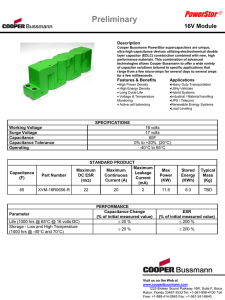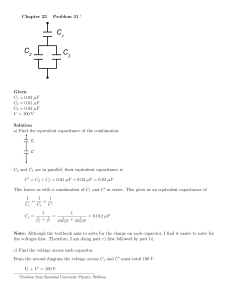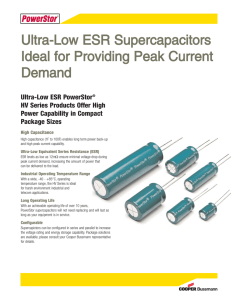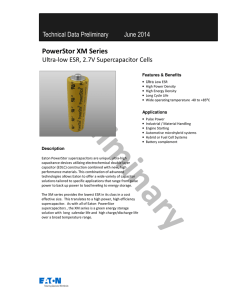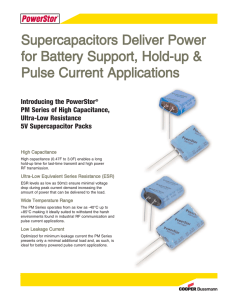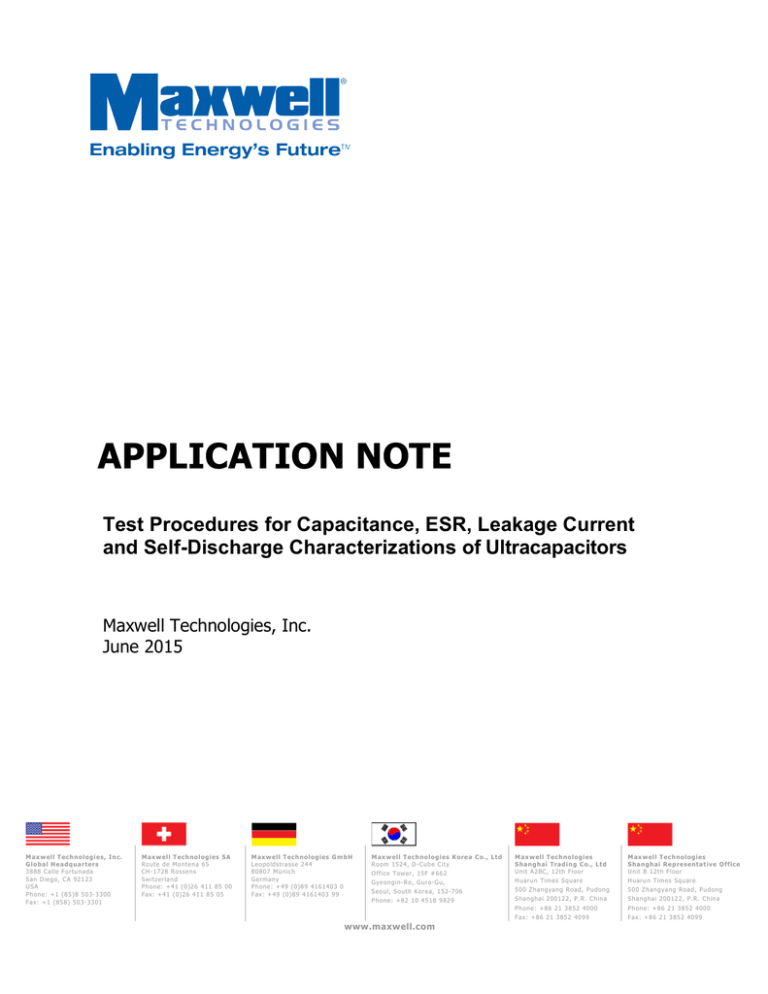
APPLICATION NOTE
Test Procedures for Capacitance, ESR, Leakage Current
and Self-Discharge Characterizations of Ultracapacitors
Maxwell Technologies, Inc.
June 2015
M axw ell Technologies, Inc.
G lobal H eadqu arters
3888 Calle Fortunada
San D iego, CA 92123
U SA
Phone: + 1 (85)8 503-3300
Fax: + 1 (858) 503-3301
M axw ell Technologies SA
Route de M ontena 65
CH -1728 Rossens
Sw itzerland
Phone: + 41 (0)26 411 85 00
Fax: + 41 (0)26 411 85 05
M axw ell Technologies G m bH
Leopoldstrasse 244
80807 M ünich
G erm any
Phone: + 49 (0)89 4161403 0
Fax: + 49 (0)89 4161403 99
M axw ell Technologies K orea C o., Ltd
Room 1524, D -Cube City
O ffice Tow er, 15F # 662
G yeongin-Ro, G uro-G u,
Seoul, South Korea, 152-706
Phone: + 82 10 4518 9829
www.maxwell.com
M axw ell Technologies
Shanghai Trading C o., Ltd
U nit A2BC, 12th Floor
H uarun Tim es Square
M axw ell Technologies
Shanghai R epresentative O ffice
U nit B 12th Floor
H uarun Tim es Square
500 Zhangyang Road, Pudong
Shanghai 200122, P.R. China
500 Zhangyang Road, Pudong
Shanghai 200122, P.R. China
Phone: + 86 21 3852 4000
Phone: + 86 21 3852 4000
Fax: + 86 21 3852 4099
Fax: + 86 21 3852 4099
MAXWELL TECHNOLOGIES APPLICATION NOTE
Test Procedures for Capacitance, ESR, Leakage Current and Self-Discharge Characterizations of
Ultracapacitors
1.
Introduction
A capacitor is an electronic device which can store energy in the electrical field between two
conductors (“plates”). Ultracapacitors, or electric double layer capacitors (EDLC), are
electrochemical capacitors which have a very large energy density as compared to common
capacitors. The large energy density is due to the enormous surface area created by the porous
carbon electrodes and the small charge separation created by the dielectric separator.
An ideal capacitor is characterized by a single constant value, capacitance, which is the ratio of
the electric charge on each conductor to the potential difference between them. In reality, we
measure the integral average value,
!"
!∆!
𝐶 = !" or 𝐶 = ∆! (if the current is a constant value)
(1)
The amount of energy stored in the capacitor is given by
𝐸 = !" !
(2)
!
In practice, the dielectric between the plates passes a small amount of leakage current which will
cause the voltage decay of a charged ultracapacitor over time. The conductors, leads and other
factors introduce an equivalent series resistance (ESR). Capacitance, ESR and leakage/selfdischarge are the three of the major parameters used to evaluate an ultracapacitors
performance as an energy storage device; they characterize the capability to store the electrical
charge (energy), the efficiency during charge/discharge, and the ability to hold the energy after
charge.
2.
Capacitance and ESR Characterization Test – Maxwell 6-Step Process
The measured capacitance and ESR values of an ultracapacitor depend on different test
conditions, such as frequency, current, temperature, voltage, humidity, etc. The capacitance
and ESR dependency on the frequency is tested by an impedance test. The test method
discussed in this article is for a DC application only.
There are various methods to test, measure and calculate capacitance and ESR, but all methods
are based on the same assumption: that the ultracapacitor can be represented by a simple RC
equivalent circuit described in the following picture.
1007239-EN.2
www.maxwell.com | 2
MAXWELL TECHNOLOGIES APPLICATION NOTE
Test Procedures for Capacitance, ESR, Leakage Current and Self-Discharge Characterizations of
Ultracapacitors
Figure 1. RC equivalent circuit of an ultracapacitor
Where the voltage measured between the two terminals of the ultracapacitor:
(3)
𝑉 = 𝑉! + 𝑉!
Therefore, during constant current charge and discharge:
𝑉 = 𝑉! + 𝐼 ∗ 𝑅
(4)
!!!!
(5)
𝑅 = !
At open circuit, the measured ultracapacitor voltage:
(6)
𝑉 = 𝑉!
The capacitance value for certain constant current can be derived from equation (1):
𝐶 = (!
!∗ ∆!
(7)
!"#$%&"_!"# ! !!"#$%&"_!"#$")
The formulas listed above hold the principles of capacitance and ESR test and calculation.
There are four factors to be considered in the design of the test cycle for capacitance and ESR
characterizations:
• How to charge and discharge the ultracapacitor?
• What to do between charge and discharge: hold (keep charging to the given voltage)
or rest (open circuit) and for how long?
•
•
At what voltage to start and end the charge/discharge?
At which points to do the measurement?
We know from equation (2) that when the voltage of the ultracapacitor drops to one-half of the
rated voltage there is only 25% of the energy stored remaining. For this reason the common
1007239-EN.2
www.maxwell.com | 3
MAXWELL TECHNOLOGIES APPLICATION NOTE
Test Procedures for Capacitance, ESR, Leakage Current and Self-Discharge Characterizations of
Ultracapacitors
operational voltage range for an ultracapacitor is from rated voltage to one-half rated voltage.
During characterization testing the charge/discharge steps have to at least include the range
from rated voltage to one-half rated voltage. Compared to open circuit, holding the charge of
the ultracapacitor at the rated voltage before discharge provides higher capacitance value. At
very slow charges, the ions can travel to the deeper pores inside the electrode which
additionally contributes to the measured capacitance value. There are more applications which
rest between charge and discharge than which hold the charge. In real applications, the
purpose of holding the voltage is to compensate for the leakage of the ultracapacitor to
maintain the voltage level, not to increase the capacitance to store more energy. Therefore the
benefit of holding the voltage during the test to achieve a higher capacitance measurement
value is insignificant.
Considering the above facts and principles, as well as the efficiency and cost involved in the
production line, Maxwell Technologies uses a constant current test method for capacitance and
ESR characterization for all ultracapacitor products, single cells and modules. We call this test
method the 6-step process.
The following steps describe the 6-step process Maxwell Technologies uses for measuring the
capacitance and ESR of ultracapacitors and modules:
Test Considerations:
•
Short circuit the cell at least one hour before the test
•
Rest cells for more than 4 hours between different tests
•
If using a temperature-controlled chamber for tests, then the cell should stay in the
chamber at the test temperature for a suitable soak period for thermal equalization
(6 hours is recommended for the Maxwell cells).
Test Equipment:
•
•
Bitrode Test System or any other test system which can be used to charge and
discharge ultracapacitors with test cycle programming and data acquisition
capabilities
Temperature controlled chamber if testing at any environment other than
room temperature
1007239-EN.2
www.maxwell.com | 4
MAXWELL TECHNOLOGIES APPLICATION NOTE
Test Procedures for Capacitance, ESR, Leakage Current and Self-Discharge Characterizations of
Ultracapacitors
Test Temperature:
•
•
Room temperature 23°C ± 2°C
Tests carried out at other temperatures should be performed in a temperature controlled
chamber
Test Current:
•
•
One constant current value for charge and discharge, current rate at about
100mA/F, refer to Table 1. Maxwell Baseline Test Current
Different current within the maximum limit specified by the test equipment
manufacturer can be applied to the test.
Table1. Maxwell Baseline Test Current
Product
BCAP25
BCAP50
BCAP310
BCAP350
BCAP650
BCAP1200
BCAP1500
BCAP2000
BCAP3000
BCAP3400
Nominal Capacity (F)
Rated Voltage (V)
Current (A)
Test Current
25
50
310
350
650
1200
1500
2000
3000
3400
2.7
2.7
2.5
2.5
2.7
2.7
2.7
2.7
2.7
2.85
2.5
5.0
31.0
35.0
65.0
120.0
150.0
200.0
300.0
340.0
2.5
5
31
35
65
100*
100*
100*
100*
100*
*Limitation of the production test equipment
1007239-EN.2
www.maxwell.com | 5
MAXWELL TECHNOLOGIES APPLICATION NOTE
Test Procedures for Capacitance, ESR, Leakage Current and Self-Discharge Characterizations of
Ultracapacitors
Test Process:
Step 1.
Rest (Open Circuit)
• 10 seconds
• Record test time, test current and test article’s voltage at end of the rest (t1,
I1, V1).
Step 2.
Charge
• Charge device to its rated voltage at specified current.
• Record test time, test current and test article’s voltage at end of the rest (t2,
I2, V2).
Step 3.
Rest (Open Circuit)
• 5 seconds
• Record test time, test current and test article’s voltage at end of the rest (t3,
I3, V3).
Step 4.
Rest (Open Circuit)
• 10 seconds
• Record test time, test current and test article’s voltage at end of the rest (t4,
I4, V4).
Step 5.
Discharge
• Discharge device to one-half its rated voltage at its specified current.
• Record test time, test current and test article’s voltage at end of the rest (t5,
I5, V5).
Step 6.
Rest (Open Circuit)
• 5 seconds
• Record test time, test current and test article’s voltage at end of the rest (t6,
I6, V6).
Step 7.
Discharge module to a low safe voltage (<0.1V) and end test after the
second cycle
• This step is not part of the measurement. It is for safety only.
1007239-EN.2
www.maxwell.com | 6
MAXWELL TECHNOLOGIES APPLICATION NOTE
Test Procedures for Capacitance, ESR, Leakage Current and Self-Discharge Characterizations of
Ultracapacitors
The 6-step process is executed twice as described in the picture below:
Parameter Calculation:
The results of the second cycle are used to calculate the capacitance and ESR with the following
formulas. The first cycle data are not used because the cell has not been activated and the
measured capacitance and ESR values are different compared to the second cycle and the
cycles after.
•
𝐶!! = !! ∗(!! !!! )
•
𝑅!! = !! !!!
•
𝐶!"! = •
𝑅!"! = •
The calculated 𝐶!"! and 𝑅!"! are used as the capacitance and ESR values by Maxwell
Technologies.
1007239-EN.2
!! !!!
(or 𝐶!! = !!
!! ∗(!! !!! )
!! !!!
!! ∗!!
!! !!!
(or 𝐶!"! = if t2 is the step time of step 2)
!! ∗!!
!! !!!
) if t5 is the step time of step 5)
!! !!!
!!
www.maxwell.com | 7
MAXWELL TECHNOLOGIES APPLICATION NOTE
Test Procedures for Capacitance, ESR, Leakage Current and Self-Discharge Characterizations of
Ultracapacitors
3.
Test Method for Leakage Current
The leakage current is the charging current required to maintain the ultracapacitor at the
specified voltage value. The longer the ultracapacitor is held at voltage, the lower the leakage
current of the ultracapacitor. The measured result will be influenced by the temperature, the
voltage at which the device is charged, the test history of the device and the aging conditions.
The leakage current reported in Maxwell Technologies datasheets is the value of the charging
current required to maintain rated voltage after holding the ultracapacitor at rated voltage for
72 hours at room temperature. The measurement is taken immediately at the end of the 72hour period.
The following steps describe the process Maxwell Technologies uses for measuring leakage
current.
Test Temperature:
•
•
Room temperature 23°C ± 2°C
Tests carried out at other temperatures should be performed in a temperature controlled
chamber
Test Equipment:
•
•
•
Power supply equipment which can be used to charge ultracapacitors
Data acquisition unit
1Ω, precision resistor 𝑅!"#
Test Setup:
•
•
•
•
•
•
Connect 𝑅!"# in series with the ultracapacitor to be tested
Connect the positive terminal of the Voltage Power Supply to the positive terminal of
the cell
Connect the negative terminal of the Voltage Power Supply to the negative terminal of
the cell
Connect the positive terminal of the Data Acquisition Unit to the positive side of 𝑅!"#
Connect the negative terminal of the Data Acquisition Unit to the negative side of 𝑅!"#
Install jumper across 𝑅!"# to expedite the charge cycle before the 72 hours’ hold
Charge Current:
•
•
The charge current should be within the maximum current limit of the ultracapacitor
Suggested current, refer to Table 1 Maxwell Baseline test current
1007239-EN.2
www.maxwell.com | 8
MAXWELL TECHNOLOGIES APPLICATION NOTE
Test Procedures for Capacitance, ESR, Leakage Current and Self-Discharge Characterizations of
Ultracapacitors
Test Procedure:
•
•
•
•
•
Charge cell/module to the rated voltage
Hold voltage for one hour
Remove the jumper across 𝑅!"#
Continue to hold voltage for 72 hours
Measure and record the voltage of 𝑅!"#
Parameter Calculation:
•
Leakage Current (A) =
!!"#
!!"#
Table 2. Maxwell Production Cell Maximum Leakage Current
Product
BCAP25
BCAP50
BCAP310
BCAP350
BCAP650
BCAP1200
BCAP1500
BCAP2000
BCAP3000
BCAP3400
1007239-EN.2
Nominal Capacitance (F)
Leakage Current Maximum (mA)
25
50
310
350
650
1200
1500
2000
3000
3400
0.045
0.075
0.45
0.3
1.5
2.7
3.0
4.2
5.2
15.0
www.maxwell.com | 9
MAXWELL TECHNOLOGIES APPLICATION NOTE
Test Procedures for Capacitance, ESR, Leakage Current and Self-Discharge Characterizations of
Ultracapacitors
4.
Test Method for Self-Discharge
The self-discharge test is designed to see the natural decay of the ultracapacitor voltage over
time after it is fully charged to a certain voltage. The measured result will be influenced by the
temperature, the voltage at which the device is charged, the test history and the aging condition.
The typical test setup is to measure the voltage over 72 hours open circuit at room temperature
after charging the ultracapacitor to the rated voltage. To ensure the ultracapacitor is completely
charged it is necessary to hold the rated voltage for one hour.
The following steps describe the process Maxwell Technologies uses for measuring
self-discharge.
Test Temperature:
•
•
Room temperature 23°C ± 2°C
Tests carried out at other temperatures should be performed in a temperature controlled
chamber
Test Equipment:
•
•
Power supply equipment which can be used to charge ultracapacitors
Data acquisition unit
Charge Current:
•
•
The charge current should be within the maximum current limit of the ultracapacitor
Suggested current, refer to Table 1 Maxwell Baseline test current
Test Procedure:
•
•
•
•
Charge cell/module to the rated voltage
Hold voltage for one hour
Open circuit the cell/module 72 hours
Measure and record the voltage of cell/module
Parameter Calculation:
•
Self-discharge (Volts) = 𝑎𝑏𝑠(𝑉 – 𝑉0) if reported as absolute charge
•
Self-discharge (%) = 𝑎𝑏𝑠(100 ×
1007239-EN.2
! – !0
!0
) if reported as percent of voltage charge
www.maxwell.com | 10
MAXWELL TECHNOLOGIES APPLICATION NOTE
Test Procedures for Capacitance, ESR, Leakage Current and Self-Discharge Characterizations of
Ultracapacitors
5.
Conclusions
The test methods for leakage current and self-discharge are consistent industry wide. However,
there are various methods for capacitance and ESR characterization. Compared to other
capacitance and ESR testing methods (such as IEC62391 and EUCAR), the Maxwell 6-step
process has the following advantages:
•
•
•
•
•
The Maxwell 6-step process requires less test time, which makes it more efficient for
a production line environment. Other test methods use a holding period between
charge and discharge, which makes the test time longer and inefficient in a production
line environment.
The Maxwell 6-step process requires that you record only the end of value of each
step. The calculation is simple to manage as compared to other methods.
The Maxwell 6-step process can measure capacitance and ESR from low to high
current for small cells to large modules. Some of the other calculation methods
cannot be used to compute ESR at low current.
The Maxwell 6-step process determines both Capacitance and ESR values in one
approach. Other methods use different approaches to measure capacitance and ESR.
The Maxwell 6-step process provides capacitance and ESR values for both
charge and discharge where other methods provide the values for discharge only.
The Maxwell 6-step process has been used for many years at Maxwell Technologies’ test labs
and production lines, and provides accurate and reliable results.
MAXWELL TECHNOLOGIES, MAXWELL, MAXWELL CERTIFIED INTEGRATOR, ENABLING ENERGY’S FUTURE, BOOSTCAP, C CELL, D
CELL, CONDIS, RAD-PAK and their respective designs and/or logos are either trademarks or registered trademarks of Maxwell
Technologies, Inc. and may not be copied, imitated or used, in whole or in part, without the prior written permission Maxwell
Technologies, Inc. All contents copyright © 2015 Maxwell Technologies, Inc. All rights reserved. No portion of these materials may
be reproduced in any form, or by any means, without prior written permission from Maxwell Technologies, Inc.
1007239-EN.2
www.maxwell.com | 11


